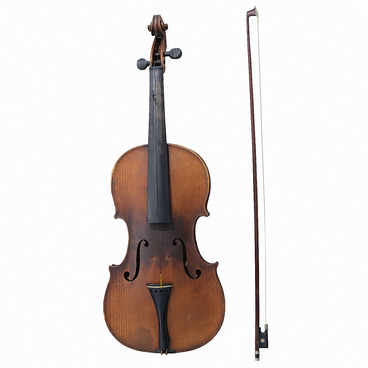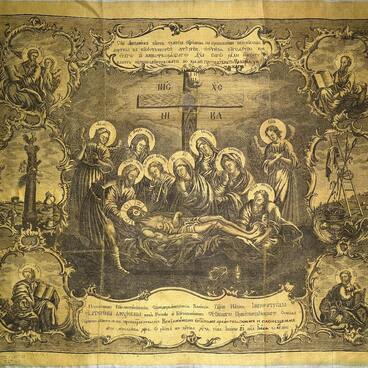The Divine Liturgy is the main Christian service during which the great sacrament of the Eucharist takes place. According to church teaching, through prayers, the gifts of bread and wine are changed into the body and blood of Jesus Christ. By partaking of the bread and wine, the believers partake of Jesus.
During the liturgy, bread and wine are placed in special containers. According to church tradition, the priests also use three veils: one cross- or square-shaped veil for the Chalice (a footed cup intended to serve the wine), another cross- or square-shaped veil for the Diskos (a small round metal plate elevated by a stand and used to hold Eucharistic bread) and the Aër — a rectangular veil covering both the Chalice and Diskos. The veils first appeared in ancient times and were used to protect the Holy Gifts from insects in hot countries.
In old inventories, the veils for the Chalice and Diskos are listed in pairs while the Aër is a separate item. Up to the end of the 16th century, the little veils and the Aërs could be decorated in different ways, and only after that time, sets of three liturgical items started to appear in Russia.
The museum collection houses a complete set of three liturgical items — two little veils and an Aër. Each of the items is an embroidered rectangular veil depicting a specific scene. “The Lamb” is embroidered on the diskos veil, “The Crucifixion” on the chalice veil, and “The Entombment of Christ” on the Aër.
The veil depicts the Lamentation of Christ. The body of Jesus with crossed arms is wrapped in the shroud. His head rests on the hands of the bowing mother Mary. The Myrrhbearers and Jesus’ disciples, including Mary Magdalene, Mary of Clopas, John, Nicodemus, and Joseph, are also seen mourning over his body.
This type of various embroidered icons depicting saints is called “pictorial embroidery”. This craft was mostly developed in women’s monasteries. Nuns embroidered the images of saints on a thin silk fabric attached to a strong canvas. Similar to the painting of icons on wooden panels, at first, the general composition was drawn. The drawing was usually made by an icon painter. Then the fabric was placed on a square canvas stretcher, and a craftswoman would start embroidering the icon. The image was divided into separate sections, which the craftswoman embroidered with silk, silver or gold thread. The stitches are different in each section, thus imitating the patterns of metalsmithing.
In the Aër from the museum’s collection, the images of saints are embroidered with silk. The other images and the background of the centerpiece were created using the couching technique with silver and gold thread. In this technique, a twisted metal thread is attached by a thinner thread stitch. The instruments of the Passion — the cross, the spear, and the pillar — as well as the contours of halos and inscriptions, are decorated with pearls framed with gold and silver ropes.
During the liturgy, bread and wine are placed in special containers. According to church tradition, the priests also use three veils: one cross- or square-shaped veil for the Chalice (a footed cup intended to serve the wine), another cross- or square-shaped veil for the Diskos (a small round metal plate elevated by a stand and used to hold Eucharistic bread) and the Aër — a rectangular veil covering both the Chalice and Diskos. The veils first appeared in ancient times and were used to protect the Holy Gifts from insects in hot countries.
In old inventories, the veils for the Chalice and Diskos are listed in pairs while the Aër is a separate item. Up to the end of the 16th century, the little veils and the Aërs could be decorated in different ways, and only after that time, sets of three liturgical items started to appear in Russia.
The museum collection houses a complete set of three liturgical items — two little veils and an Aër. Each of the items is an embroidered rectangular veil depicting a specific scene. “The Lamb” is embroidered on the diskos veil, “The Crucifixion” on the chalice veil, and “The Entombment of Christ” on the Aër.
The veil depicts the Lamentation of Christ. The body of Jesus with crossed arms is wrapped in the shroud. His head rests on the hands of the bowing mother Mary. The Myrrhbearers and Jesus’ disciples, including Mary Magdalene, Mary of Clopas, John, Nicodemus, and Joseph, are also seen mourning over his body.
This type of various embroidered icons depicting saints is called “pictorial embroidery”. This craft was mostly developed in women’s monasteries. Nuns embroidered the images of saints on a thin silk fabric attached to a strong canvas. Similar to the painting of icons on wooden panels, at first, the general composition was drawn. The drawing was usually made by an icon painter. Then the fabric was placed on a square canvas stretcher, and a craftswoman would start embroidering the icon. The image was divided into separate sections, which the craftswoman embroidered with silk, silver or gold thread. The stitches are different in each section, thus imitating the patterns of metalsmithing.
In the Aër from the museum’s collection, the images of saints are embroidered with silk. The other images and the background of the centerpiece were created using the couching technique with silver and gold thread. In this technique, a twisted metal thread is attached by a thinner thread stitch. The instruments of the Passion — the cross, the spear, and the pillar — as well as the contours of halos and inscriptions, are decorated with pearls framed with gold and silver ropes.



